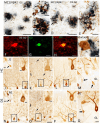Down Syndrome Biobank Consortium: A perspective
- PMID: 38270275
- PMCID: PMC10984425
- DOI: 10.1002/alz.13692
Down Syndrome Biobank Consortium: A perspective
Abstract
Individuals with Down syndrome (DS) have a partial or complete trisomy of chromosome 21, resulting in an increased risk for early-onset Alzheimer's disease (AD)-type dementia by early midlife. Despite ongoing clinical trials to treat late-onset AD, individuals with DS are often excluded. Furthermore, timely diagnosis or management is often not available. Of the genetic causes of AD, people with DS represent the largest cohort. Currently, there is a knowledge gap regarding the underlying neurobiological mechanisms of DS-related AD (DS-AD), partly due to limited access to well-characterized brain tissue and biomaterials for research. To address this challenge, we created an international consortium of brain banks focused on collecting and disseminating brain tissue from persons with DS throughout their lifespan, named the Down Syndrome Biobank Consortium (DSBC) consisting of 11 biobanking sites located in Europe, India, and the USA. This perspective describes the DSBC harmonized protocols and tissue dissemination goals.
Keywords: Alzheimer's disease; Down syndrome; biobanking; brain banking; repository; research.
© 2024 The Authors. Alzheimer's & Dementia published by Wiley Periodicals LLC on behalf of Alzheimer's Association.
Conflict of interest statement
The authors declare no conflicts of interest. Author disclosures are available in the supporting information.
Figures


References
-
- Zigman WB. Atypical aging in Down syndrome. Dev Disabil Res Rev. 2013;18:51‐67. - PubMed
-
- Wisniewski KE, Dalton AJ, McLachlan C, Wen GY, Wisniewski HM. Alzheimer's disease in Down's syndrome: clinicopathologic studies. Neurology. 1985;35:957‐961. - PubMed
-
- Wisniewski KE, Wisniewski HM, Wen GY. Occurrence of neuropathological changes and dementia of Alzheimer's disease in Down's syndrome. Ann Neurol. 1985;17:278‐282. - PubMed
Publication types
MeSH terms
Grants and funding
- R01 AG085572/AG/NIA NIH HHS/United States
- P30 AG066512/AG/NIA NIH HHS/United States
- R01AG071228/GF/NIH HHS/United States
- R01 AG071228/AG/NIA NIH HHS/United States
- RF1 AG077103/AG/NIA NIH HHS/United States
- RF1 AG070153/AG/NIA NIH HHS/United States
- P01AG060882/GF/NIH HHS/United States
- P01 AG060882/AG/NIA NIH HHS/United States
- R01 AG074004/AG/NIA NIH HHS/United States
- R01AG070153/GF/NIH HHS/United States
- P01 AG017617/AG/NIA NIH HHS/United States
- RF1 AG081286/AG/NIA NIH HHS/United States
- R01AG061566/GF/NIH HHS/United States
- P30 AG066519/AG/NIA NIH HHS/United States
- U19 AG068054/AG/NIA NIH HHS/United States
- RF1 AG061566/AG/NIA NIH HHS/United States
- P30AG066512/GF/NIH HHS/United States
- P01 AG014449/AG/NIA NIH HHS/United States
LinkOut - more resources
Full Text Sources
Medical
Miscellaneous

